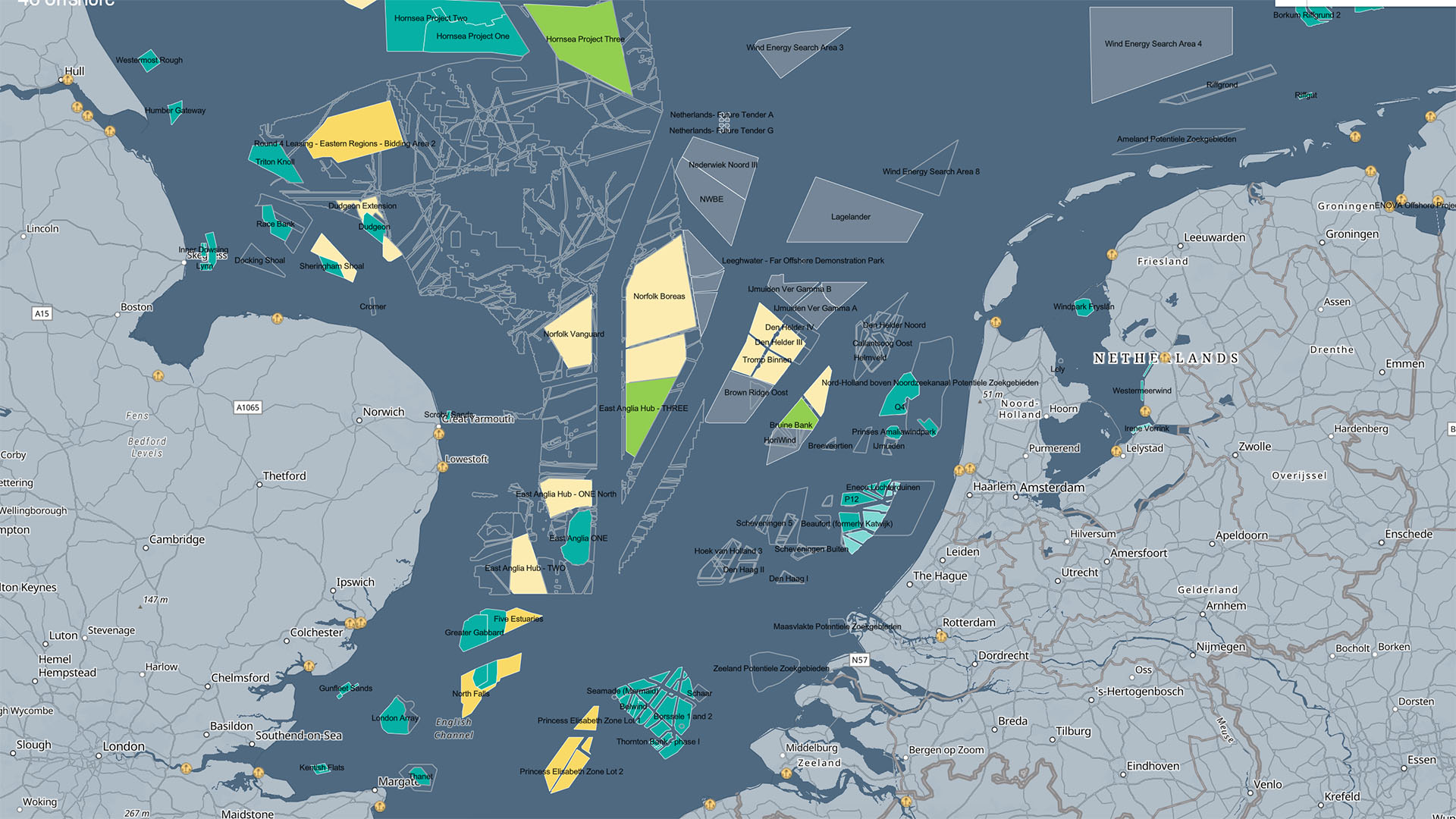Solar energy continues to reshape the global energy landscape, driving remarkable job growth and establishing itself as a cornerstone of the renewable energy transition.
In the early 2000s, solar jobs were largely niche, limited to a few specialised roles in research & development and small-scale installations. According to IRENA 2024 report, the renewable energy industry now supports over 16.2 million jobs worldwide, with over 7 million jobs in solar PV and heating/cooling alone. This positions solar as the largest employer in the renewable energy industry.
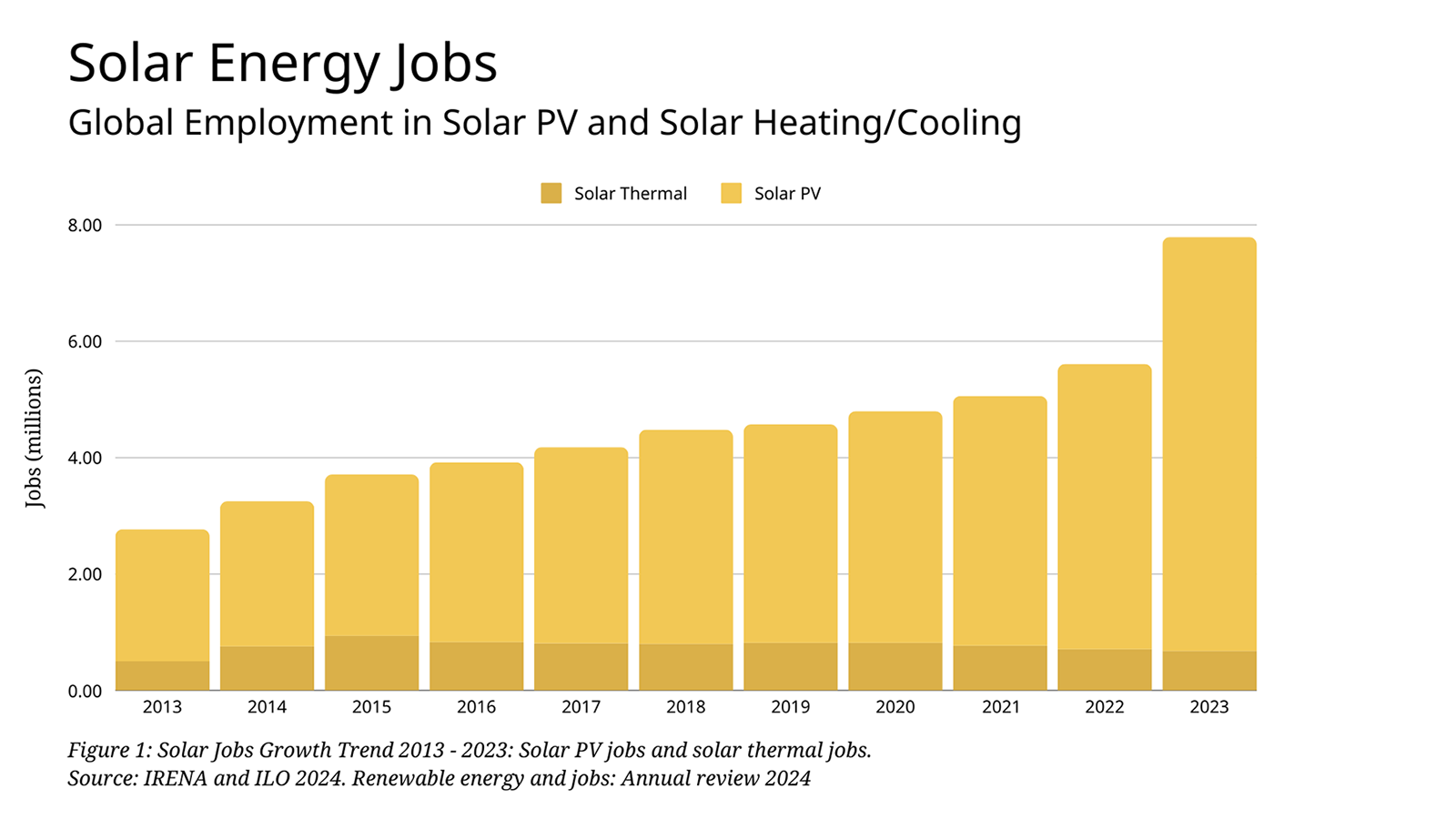
Solar technology has moved beyond early adoption to large-scale deployment. Advances such as floating solar farms, bifacial panels and perovskite cells keep pushing efficiency to new records, with governments and companies investing heavily in development and deployment of solar technology. The world now invests almost twice as much in clean energy as it does in fossil fuels, supported by ambitious policies like the IRA in the US, which allocates $369 billion over ten years to support renewable energy, pollution reduction and environmental justice, and the European Union's REPowerEU plan, which calls for 740 GW of solar capacity by 2030 (for reference: 347 GW of solar capacity was added in 2023 worldwide).
There are six major links in the solar energy value chain:
- Research
- Manufacturing
- Project Development
- Installation and O&M
- Energy Distribution and Operations
- Policy and Advocacy
These segments of solar energy value chain offer job opportunities for people from a wide range of professional and educational backgrounds. This guide explores these segments from a career perspective to help you identify roles that match your skills, interests and ambitions.
Solar Energy Value Chain
The solar energy value chain starts with the development of innovative technologies, and ends with the delivery of electricity to end users. Together, these segments scale up solar energy as a reliable and sustainable source of electricity for the twenty-first century. Understanding where opportunities exist within these segments - and how they align with specific skills and career goals - will help you navigate this transformative industry.
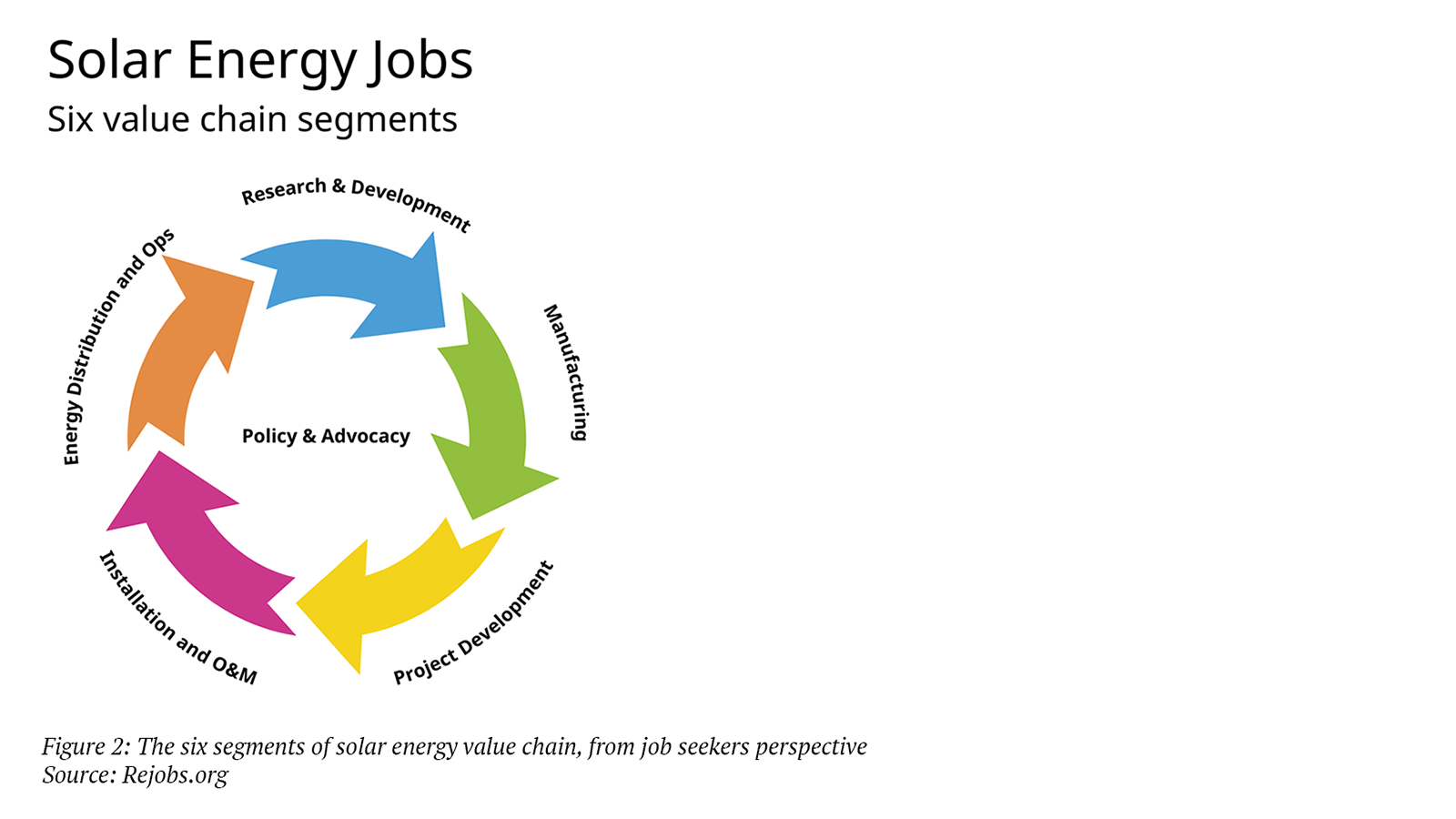
Let’s discuss what are the current trends within the value chain segments, where are the major geographical hotspots, and some practical insights.
1. Research and Development (R&D)
Activities and focus
- Development of advanced PV materials: Efforts are currently focused on improving traditional silicon cells and developing next-generation materials such as perovskites, which promise higher efficiencies at lower production costs.
- Innovations in solar panel design: Thin-film solar panels, bifacial modules and lightweight flexible panels.
- Integration of energy storage: Battery technologies and thermal storage that overcome the intermittent nature of solar energy.
- AI and IoT applications: Software tools that enable real-time system optimisation, predictive maintenance, and resource planning.
- Floating solar panels on reservoirs and offshore sites as a solution to land scarcity.
Global hotspots
- USA: National labs such as NREL in Colorado and companies such as First Solar and SunPower are leading R&D in the US.
- China: Research is closely linked to manufacturing giants such as LONGi and JA Solar.
- Germany: Fraunhofer ISE with a focus on grid integration and system efficiency.
- India: Affordable solar solutions are being spearheaded by the Indian Institute of Science (IISc) and start-ups working on rural electrification.
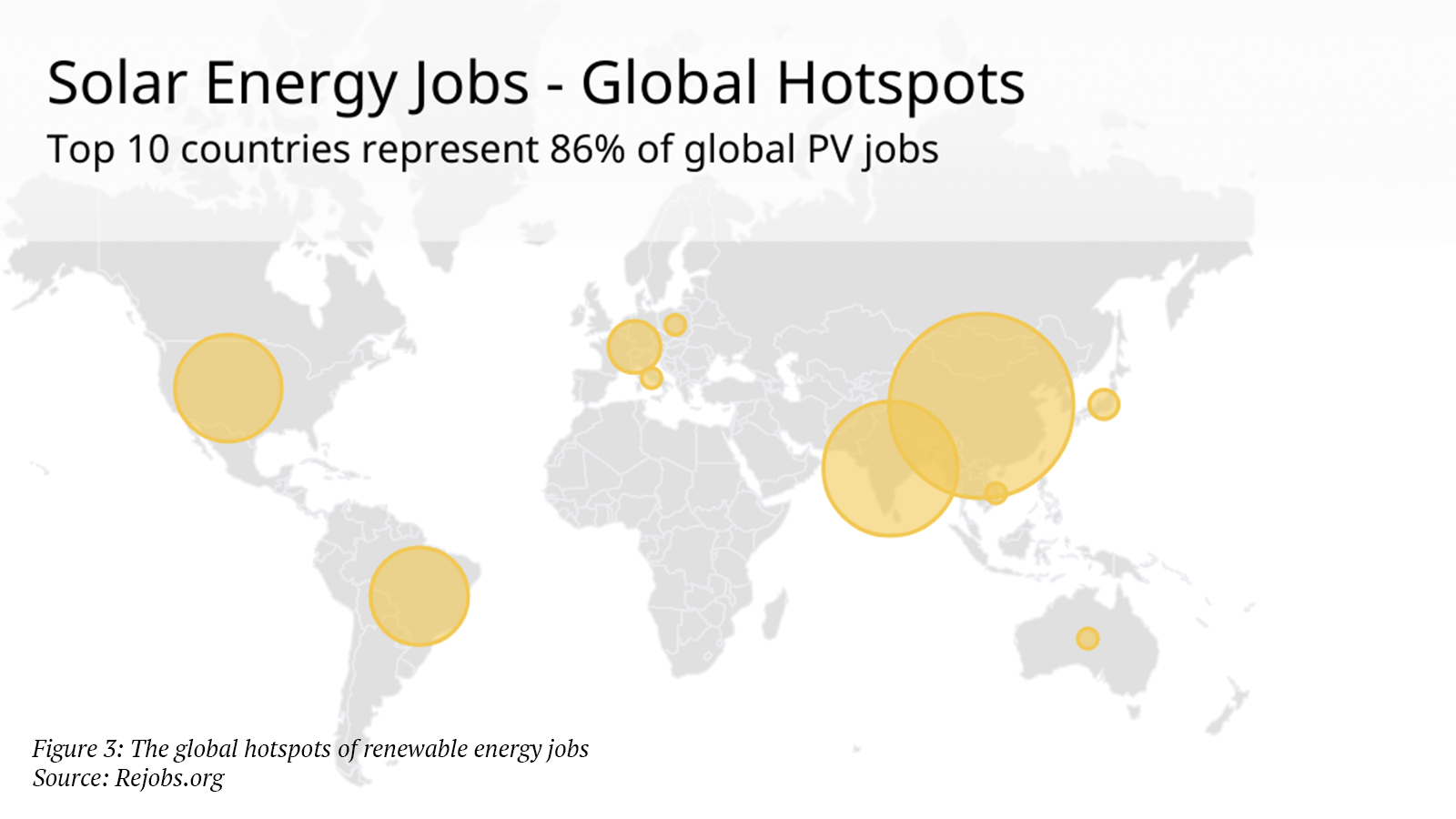
What to Expect in Solar R&D Jobs
Most research and development positions in solar energy require advanced degrees in physics, materials science, electrical engineering, or similar. The work environment is typically dynamic, involving a mix of lab work, office time, and occasional visits to manufacturing facilities. You'll need to be comfortable with simulation software, data analysis tools, and laboratory equipment.
R&D professionals often split their time between hands-on research and collaboration with (international) teams. You may find yourself contributing to research papers, presenting findings at conferences, and working closely with academic institutions and industry partners. The field offers considerable flexibility and the opportunity to make significant global impact.
Career progression often starts with internships at leading companies and organisations. Many professionals move between academia and industry throughout their careers, building expertise in both theoretical research and practical applications.
Be prepared for a fast-paced environment that requires continuous learning. You'll need to balance pure research goals with commercial viability, and often compete for funding and resources.
2. Manufacturing
Activities and Focus
- PV cell manufacturing: Precision processes such as doping and encapsulation that create highly efficient solar cells.
- Panel assembly and hardware manufacturing: Solar panels assembled alongside inverters, mounting systems, and trackers.
- Automation and scaling: Robotics and AI-driven production lines that improve output quality and efficiency.
- Another current trend is vertical integration, where companies control the entire process from silicon refining to panel assembly.
- Recycling efforts are also expanding to reduce waste from decommissioned panels.
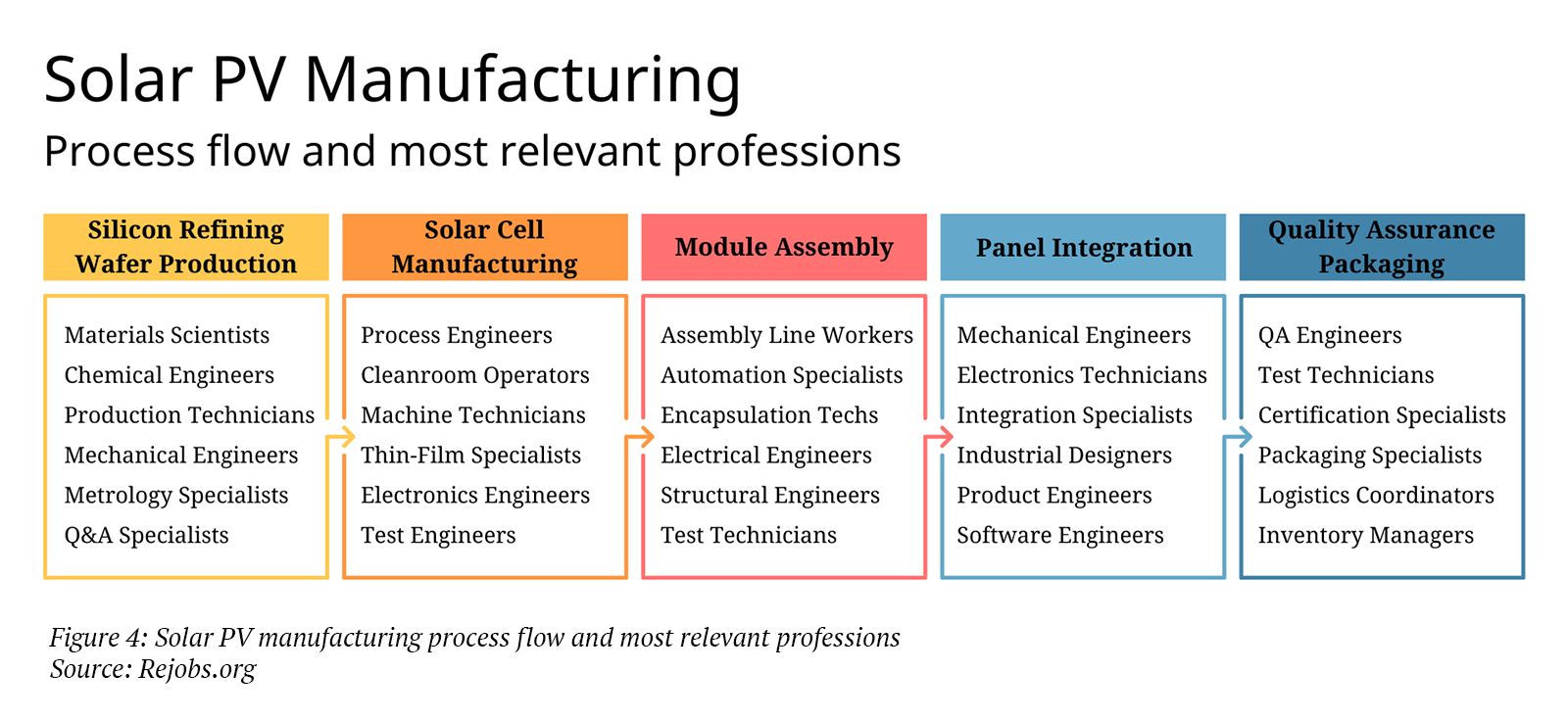
Global Hotspots
- China: The world leader, with companies such as LONGi and Trina Solar producing at on an unparalleled scale. Jiangsu province is an important hub.
- South East Asia: Vietnam and Malaysia are major players, attracting manufacturers diversifying away from China.
- India: Rapidly expanding its manufacturing capacity to meet ambitious domestic solar targets.
- USA: Companies such as First Solar are focusing on high-quality panels with advanced manufacturing techniques.
What to Expect
You can start a career in solar manufacturing in many different ways, from production line technicians to specialised engineering roles. Production facilities typically operate around the clock, so you should be prepared for shift work and maintaining a flexible schedule. Many positions require working in clean room environments where strict protocols must be followed.
For engineering positions, expertise in robotics and process automation is highly valued. The industry is quickly evolving, with new opportunities emerging in areas like solar panel recycling and advanced silicon manufacturing. This means you'll need to commit to continuous learning to stay current with new technologies and processes.
Physical aspects of the job are also important to consider. Many roles involve walking for extended periods or handling materials, so good physical stamina is essential. And since safety is always a top priority, you'll receive comprehensive training on working with electrical components and industrial equipment before starting hands-on work.
3. Project Development
Activities and Focus
- Site Selection and Feasibility Studies: Evaluation of locations for solar projects, considering factors like solar irradiance, land availability, grid access, and environmental impact.
- Permitting and Approvals: The navigation of regulatory, environmental, and zoning requirements.
- Financial Modeling: Assessments of economic feasibility and development of project financing strategies, often involving power purchase agreements (PPAs).
- Stakeholder Engagement: Collaboration with local governments, utilities, and communities to ensure smooth project execution.
- Detailed Design: Translation of conceptual plans into detailed engineering blueprints.
Global Hotspots
- USA: Southwest states (e.g., Arizona, California) lead in utility-scale projects.
- India: Rooftop and ground-mounted systems are expanding rapidly.
- Europe: Countries like Spain and Portugal attract significant investment in solar farms.
- Middle East: Large-scale desert installations, such as in the UAE and Saudi Arabia.
What to expect
Project development roles in solar energy offer opportunities across engineering, finance, and management. Positions typically combine office work with regular site visits, requiring professionals to spend about 20-40% of their time in the field. The work schedule can be flexible to accommodate coordination across different time zones and stakeholder needs.
Success in these roles requires proficiency with specific tools and software. Project managers use applications like MS Project and Primavera for scheduling, while technical staff work with CAD and solar design tools such as PVsyst and HelioScope. Financial analysis is conducted using specialised solar software alongside traditional Excel modeling. Strong communication skills are essential, as professionals regularly interact with landowners, utilities, and contractors.
Daily responsibilities include conducting site assessments, developing project timelines and budgets, managing permit applications, and creating financial models for project funding. Career progression typically begins with assistant roles, with advancement to project manager positions possible within 3-5 years. The field is particularly welcoming to professionals transitioning from related industries - those with backgrounds in finance can excel in funding and analysis roles, while construction experience is valuable for project execution, and urban planning knowledge helps with permitting and compliance.
4. Installation and O&M
Activities and Focus
- System installations including residential rooftops, commercial buildings, and utility-scale solar farms.
- Grid integration: Ensuring systems connect seamlessly to local grids or operate as stand-alone units.
- Maintenance: Cleaning, diagnosing, and upgrading systems for optimal performance.
- Current Trends: Hybrid solar systems that integrate battery storage are becoming increasing popularity, especially in off-grid applications.
- AI and IoT in O&M: Real-time system monitoring and predictive maintenance powered by AI tools are becoming standard for optimizing performance and reducing downtime.
- Hybrid Solar Systems: Increasing adoption of solar installations paired with battery storage or other renewable sources.
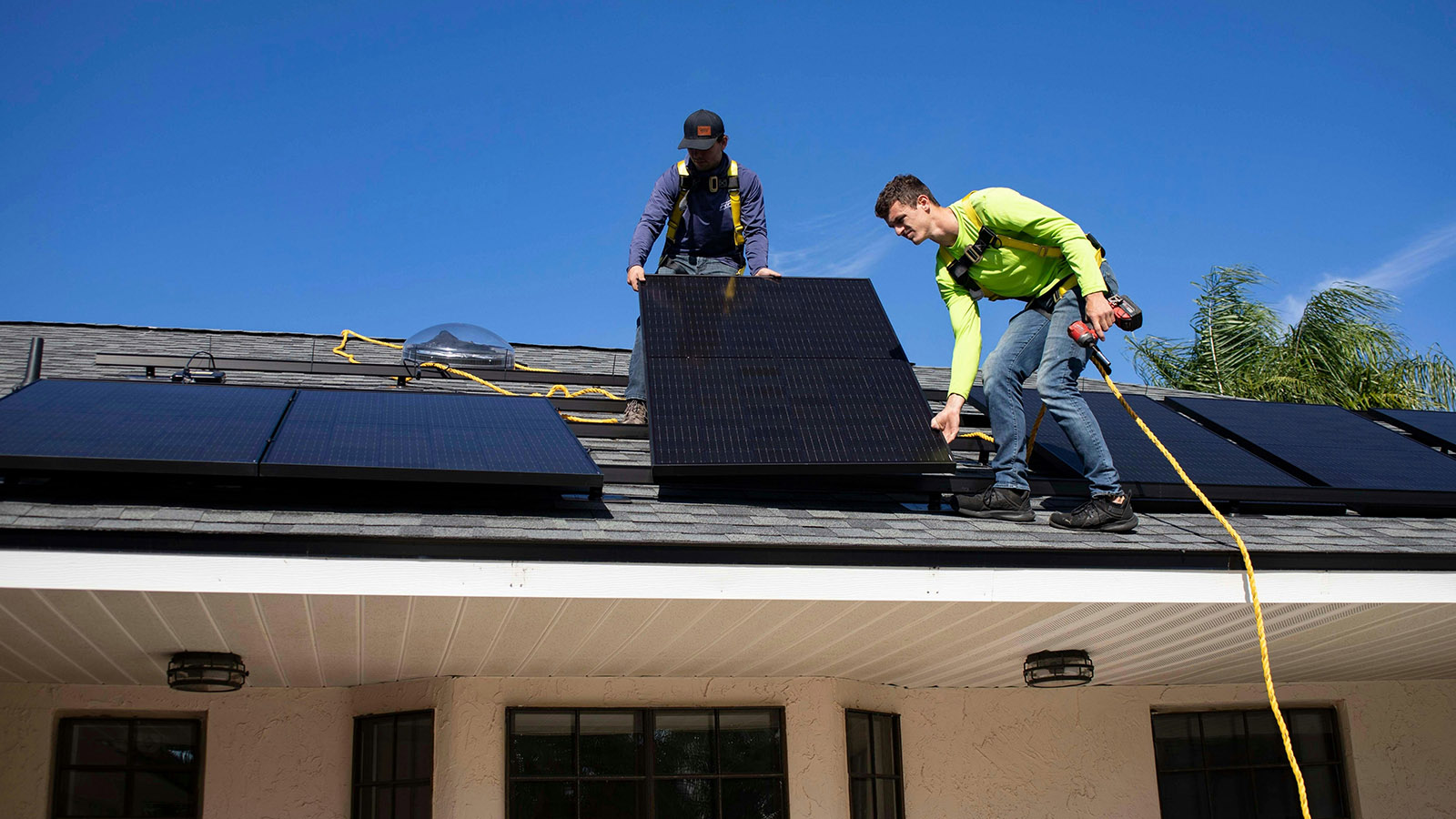
Global Hotspots
- USA: Residential installations dominate in states like California and Texas.
- India: Rooftop solar is growing rapidly in urban centres, while rural regions are focusing on solar microgrids.
- Australia: Leads in per capita rooftop installations.
- Sub-Saharan Africa: Growth in off-grid installations supports rural electrification.
What to Expect
Working in solar installation and operations & maintenance (O&M) requires specific qualifications to get started. Most employers require vocational training and industry certifications like NABCEP. However, this field offers excellent career advancement opportunities, with many professionals progressing to site management roles or specialising in emerging technologies like solar trackers.
The day-to-day work environment is physically demanding and primarily outdoors. Installers and technicians spend much of their time working at heights, climbing on roofs, and handling heavy equipment. Safety is a top priority, requiring strict adherence to protocols and proper use of safety equipment. The job also demands technical skills, including the ability to read diagrams, understand electrical systems, and use computer systems for monitoring installations.
Work schedules in solar installation and O&M can be quite variable. Early morning starts are typical, and the workload often increases during warmer months when installation conditions are optimal. Maintenance technicians may need to be available for emergency calls, sometimes including weekends. Despite these demands, the field offers strong growth potential, especially as solar technology continues to evolve, creating opportunities for continuous learning and specialisation.
5. Energy Distribution and Operations
Activities and Focus
- Grid Integration: Infrastructure for transmitting solar power from generation sites to end-users, balancing supply and demand with traditional energy sources.
- Energy Monitoring: Using SCADA (Supervisory Control and Data Acquisition) systems to track energy output and identify inefficiencies.
- Battery and Energy Storage Systems: Ensuring stable power supply and handling peak demand.
- Distributed Grids and Virtual Power Plants (VPPs): Facilitate decentralised solar adoption, where smaller systems contribute collectively to the energy grid.
Global Hotspots
- China: Leads in grid innovation, with large-scale projects involving ultra-high voltage (UHV) transmission lines.
- Europe & USA: Smart grid systems and energy storage integration are major focus areas.
- Sub-Saharan Africa: Off-grid solar solutions are expanding energy access in rural
What to Expect
Working in energy distribution and operations for solar power requires a strong technical foundation. You'll need to master SCADA systems for monitoring energy output, understand grid integration principles, and be familiar with battery storage technologies. These skills are essential as you'll be working with both traditional power sources and renewable energy systems.
The work environment is diverse and evolving. You might find yourself managing distributed grid systems or virtual power plants (VPPs), which are becoming increasingly common. Job opportunities exist in various markets - from developed regions like Europe and the USA, where smart grid technology is advancing rapidly, to emerging markets in Sub-Saharan Africa, where off-grid solutions are transforming energy access.
The field particularly welcomes Electrical Engineers and Data Analysts who can optimise energy systems, and there's growing demand for experts who can integrate solar power with EV charging infrastructure. This career path is ideal for strategic thinkers who enjoy complex problem-solving and coordination. It's also an excellent transition opportunity for professionals from traditional energy sectors, such as oil and gas, who can apply their existing knowledge to renewable energy operations.
6. Policy and Advocacy
Activities and Focus
- Policy Formulation: Develop and advocate for policies supporting solar energy adoption, such as feed-in tariffs, tax incentives, and net metering schemes.
- Community Advocacy: Ensure equitable access to solar technologies for underrepresented communities.
- Corporate Sustainability Initiatives: Guide corporations in meeting their renewable energy targets.
- Regulatory Compliance: Oversee adherence to international standards for safety, environmental impact, and grid compatibility.
- Global Advocacy: Work with international organisations (e.g., IRENA, IEA) to set solar energy goals and promote cross-border collaboration.
Global Hotspots
- Europe: The EU’s REPowerEU plan drives renewable energy advocacy and regulation.
- USA: IRA incentives are shaping solar policy and growth.
- Asia & Africa: Emerging economies focus on balancing solar expansion with affordability.
What to Expect
Working in solar policy and advocacy offers opportunities across government agencies, NGOs, and major corporations. Your daily work will focus on developing and implementing crucial initiatives like feed-in tariffs, tax incentives, and net metering schemes. You'll also play a key role in promoting community solar access and helping corporations meet their sustainability goals.
Policy analysis capabilities are essential, as you'll be evaluating and shaping renewable energy regulations. Strong negotiation skills and stakeholder management abilities as well, since you'll regularly interact with diverse groups, from local community leaders to international organisations like IRENA and IEA.
The geographic focus of your work will vary by region. In Europe, you might work on implementing the REPowerEU plan, while in the USA, the focus is often on IRA incentive programs. In emerging markets across Asia and Africa, the challenge lies in balancing solar expansion with affordability. Expect frequent travel and international collaboration, as many roles involve working across borders to develop and harmonise solar energy standards and regulations.
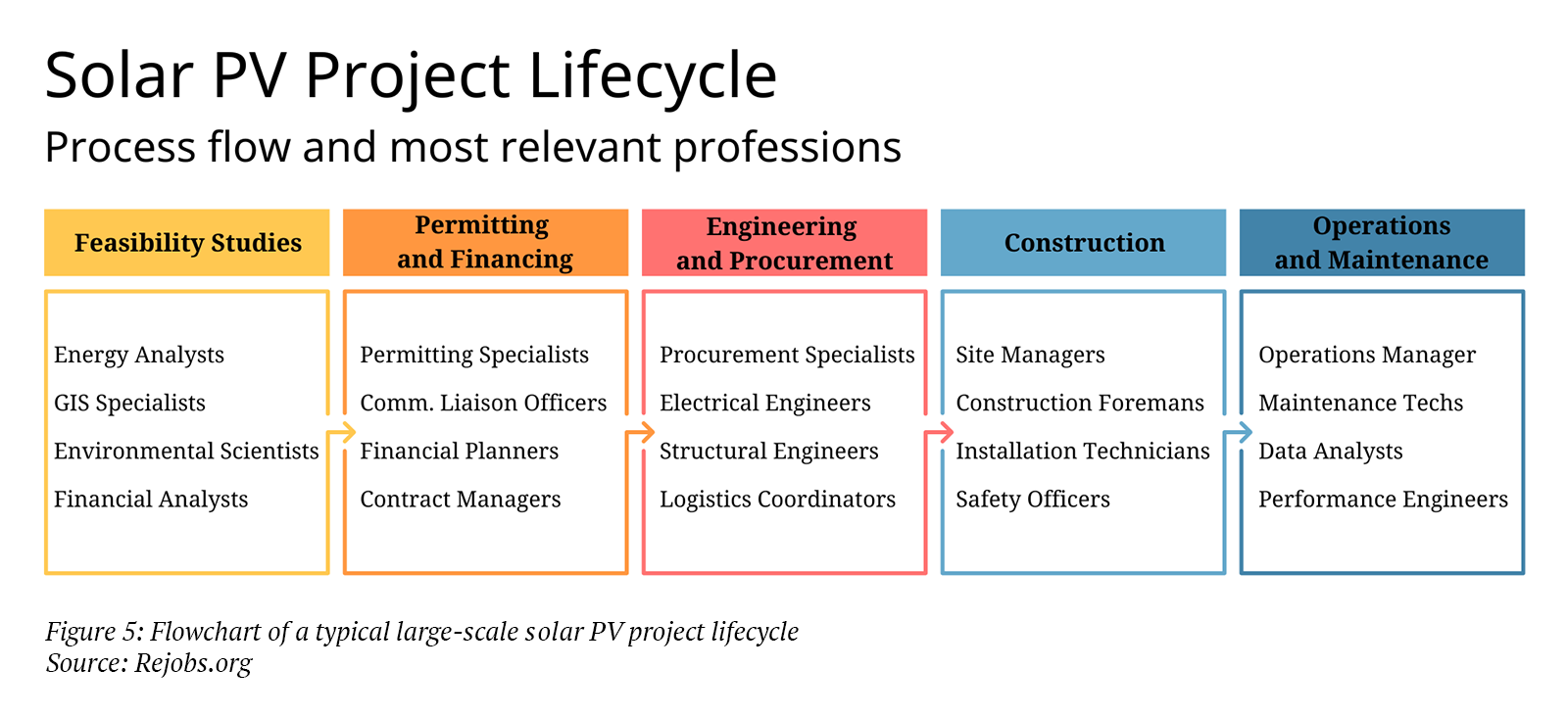
Careers That Build the Solar Value Chain
| Segment | Engineering & Design | Technicians | Business/Finance | Policy/Advocacy | Project Management |
|---|---|---|---|---|---|
| R&D | Photovoltaic Engineers, Materials Scientists, AI/IoT Specialists, Battery R&D Engineers | Lab Technicians, Cleanroom Operators | Technology Analysts, Grant Writers | Renewable Energy Policy Analysts | R&D Project Coordinators |
| Manufacturing | Process Engineers, Thin-Film Specialists, Recycling Engineers | Automation Technicians, Robotics Operators, Quality Assurance Technicians | Supply Chain Specialists, Operations Analysts | - | Production Managers |
| Project Development | Solar Design Engineers, Environmental Engineers, Grid Integration Engineers | CAD Technicians, Surveyors | Business Development Managers, Financial Modelers | Permitting Specialists | Development Project Managers |
| Installation and O&M | Performance Engineers, Electrical Engineers, Grid Integration Specialists | Solar Installers, Maintenance Technicians | Operations Analysts, Asset Managers, Field Service Coordinators | Compliance Officers | Site Managers, Operations Supervisors |
| Energy Distribution | Energy Systems Engineers, SCADA Engineers | Electrical Technicians, Monitoring Specialists | Energy Economists, Distributed Grid Specialists | Regulatory Compliance Specialists | Distribution Network Project Managers |
| Policy | Renewable Systems Engineers, Grid Policy Specialists | - | ESG Consultants, Sustainability Analysts | Policy Advisors, Advocacy Specialists | Advocacy Campaign Managers, International Policy Coordinators |
Figure 6: Matrix Chart Linking Roles and Segments
Each segment of the value chain relies on a unique mix of skills, providing opportunities for professionals from a variety of backgrounds.
Here’s how typical career paths align across the value chain:
Specialists and Innovators
R&D and manufacturing professionals are the driving force behind the industry's rapid evolution. Engineers, scientists and technologists can excel here, working on technological breakthroughs, efficient production processes and integrated storage solutions. These roles suit people with a passion for problem solving and technology development.
Hands-On Workers
For those who prefer an active, on-site role, careers in installation, maintenance and project management are perfect. Installers and technicians bring solar systems to life. Project managers oversee construction schedules and budgets. These are opportunities for people transitioning from hands-on industries such as construction.
Big-Picture Thinkers
Strategic roles in project development and energy distribution appeal to people with planning, coordination and problem-solving skills. Developers and grid specialists ensure that solar projects are viable, scalable and seamlessly integrated into existing energy systems.
Career Changers
The solar industry welcomes professionals switching from other fields. For example:
- Oil & Gas Workers: Project management or engineering experience can easily translate into roles in installation, maintenance or energy operations.
- Construction Workers: Expertise in structural systems or electrical wiring is highly valued in Installation and Project Management.
- Finance or business professionals: Skills in analysis and negotiation are applicable in project development or policy and advocacy roles.
By matching your expertise to the right segment, you can find a role that matches your skills and offers long-term growth and impact.
How to Take Your Next Steps
- Define your path: Think about whether you prefer technical innovation, hands-on roles, or strategic leadership.
- Invest in your skills: Pursue relevant certifications, training, or internships to enhance your qualifications.
- Build your network: Attend renewable energy events, network with professionals, both online and offline.
- Browse current solar energy job opportunities on Rejobs.org.
Article by Jaroslav Holub
Published on December 30, 2024
Share this blog post with your folks, and help them find a career to be proud of.



